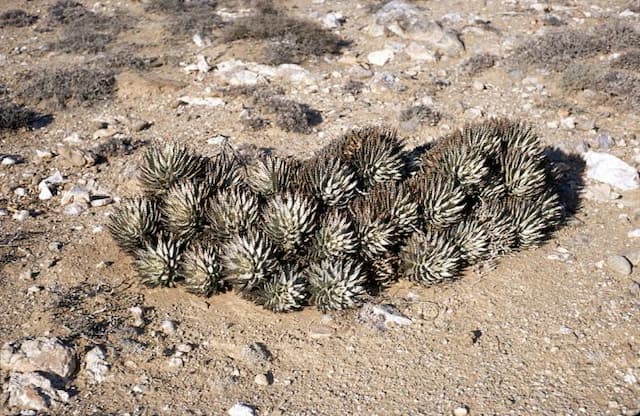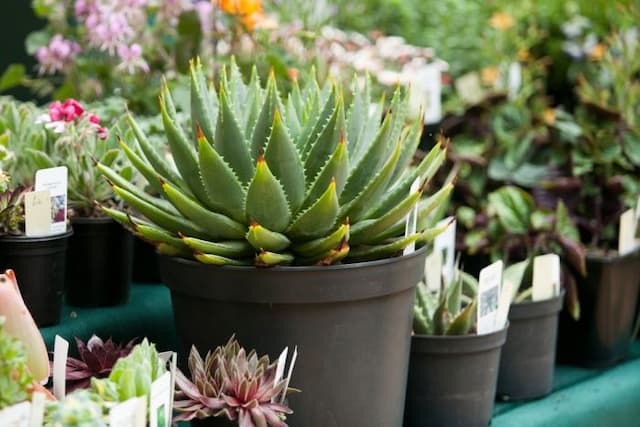Red Hot Poker Kniphofia 'Lord Roberts'

ABOUT
Kniphofia 'Lord Roberts', commonly known as Red Hot Poker or Torch Lily, is a perennial plant with striking features that create a bold visual in the garden. It is primarily known for its distinctive flower spikes which are composed of tubular flowers. These flower clusters resemble a glowing torch or poker, hence the common names. The blooms exhibit a brilliant gradation of color, starting from a rich, deep reddish-orange at the top, which softly transitions into shades of yellow towards the bottom. The foliage of 'Lord Roberts' consists of long, slender, and arching leaves that emanate from the base of the plant. The leaves are a vibrant green and have a grass-like appearance forming a dense clump that contrasts nicely with the upright and towering flowers. The vertical orientation and eye-catching colors of its inflorescence add a sense of drama and verticality to garden spaces without reference to the specific dimensions.
About this plant
 Names
NamesFamily
Asphodelaceae
Synonyms
Red Hot Poker, Torch Lily, Tritoma
Common names
Kniphofia 'Lord Roberts'.
 Toxicity
ToxicityTo humans
Red hot poker is not widely regarded as a toxic plant to humans. Most sources suggest that it is safe when touched or if small quantities are accidentally ingested. However, as with any plant material, individual allergies and sensitivities can occur. If ingested in large amounts, there is potential for stomach upset or discomfort. It is always advisable to avoid eating garden plants unless they are known to be edible and to teach children not to eat plants due to potential risks that may be associated with other species.
To pets
Red hot poker is also not widely recognized as a toxic plant to pets. It is generally considered non-toxic to dogs, cats, and other domestic animals. However, animals may have individual sensitivities, and the consumption of any plant material can potentially cause mild stomach upset or gastrointestinal irritation. If you notice your pet has eaten a significant amount of red hot poker and is showing signs of distress, it is best to consult with a veterinarian.
 Characteristics
CharacteristicsLife cycle
Perennials
Foliage type
Evergreen
Color of leaves
Green
Flower color
Orange
Height
3-4 feet (0.9-1.2 meters)
Spread
2-3 feet (0.6-0.9 meters)
Plant type
Herb
Hardiness zones
5-9
Native area
South Africa
Benefits
 General Benefits
General Benefits- Attracts pollinators: Kniphofia 'Lord Roberts', commonly known as Red Hot Poker, attracts bees, butterflies, and hummingbirds with its vibrant flowers, contributing to the health of ecosystems.
- Decorative appeal: The striking red to orange flowers add a bold splash of color to gardens, borders, and landscaping designs.
- Drought tolerance: Once established, the Red Hot Poker is capable of withstanding periods of drought, making it suitable for xeriscaping and low-water gardens.
- Easy maintenance: It is generally low-maintenance, requiring minimal care once established, and is resistant to deer and rabbits.
- Seasonal interest: The perennial nature of Red Hot Poker means it offers seasonal interest with its foliage and blooms appearing in late spring to early summer.
- Soil adaptability: It can tolerate a range of soil types, although it prefers well-draining soils, which makes it versatile for different garden settings.
- Long blooming period: Red Hot Poker has a relatively long blooming period compared to some other perennials, extending the time the garden has vibrant color.
 Medical Properties
Medical PropertiesThis plant is not used for medical purposes.
 Air-purifying Qualities
Air-purifying QualitiesThis plant is not specifically known for air purifying qualities.
 Other Uses
Other Uses- Kniphofia 'Lord Roberts', commonly known as Red Hot Poker, can be used as a natural pest barrier due to its spiky structure and dense growth which may deter small animals and rodents.
- The nectar of the Red Hot Poker can be used to make a sweet, floral-flavored syrup that can be used in cocktails and desserts, although this is not a typical application.
- Fibers from the foliage of the plant can be used in the crafting of small, natural brushes or brooms, for artisanal purposes or garden use.
- The dried seed pods of the Red Hot Poker can be used in floral arrangements and crafts for unique textural and color accents.
- Red Hot Poker is sometimes used as a dye plant for fabrics, yielding colors that can range from soft yellows to vibrant oranges depending on the mordant used.
- The striking flowers of the Red Hot Poker can be used as a natural food coloring when steeped, although it is not commonly known or practiced for this purpose.
- Red Hot Poker plants can be planted in outdoor classroom settings as they attract pollinators and serve as a teaching tool about plant ecology and biodiversity.
- The tall and robust flowering stalks of the Red Hot Poker can be used as natural stakes or supports for other, more delicate plants that might require support as they grow.
- As a visual barrier or privacy screen, Red Hot Pokers can be planted in a row because their height and density can block unwanted views without the permanence of a fence.
- When dried, the leaves and stalks of Red Hot Poker can serve as kindling or natural fire starters due to their fibrous and flammable properties.
Interesting Facts
 Feng Shui
Feng ShuiThe Red Hot Poker is not used in Feng Shui practice.
 Zodiac Sign Compitability
Zodiac Sign CompitabilityThe Red Hot Poker is not used in astrology practice.
 Plant Symbolism
Plant Symbolism- Attraction and Desire: The vibrant red color of the Red Hot Poker, which is common for the Kniphofia 'Lord Roberts', is often associated with strong emotions, making it a symbol of attraction and desire.
- Strength and Vibrancy: Given its sturdy structure and bright, fiery flowers, Red Hot Poker can also symbolize strength, vibrancy, and the ability to stand out in a crowd.
- Wealth and Prosperity: The lush appearance of the plant can symbolize wealth and prosperity, as its torch-like blooms suggest abundance.
 Water
WaterFor Red Hot Poker plants, maintain consistent moisture, especially during hot and dry periods. Water the plant deeply once a week, providing about an inch of water each time. In gallons, this translates to approximately 0.5 gallons for a 1-square-foot area, depending on soil type and climate. During the cooler seasons or in naturally moist conditions, reduce watering frequency. Ensure adequate drainage to prevent root rot and avoid overhead watering to keep the foliage dry.
 Light
LightRed Hot Pokers thrive in full sunlight, requiring at least six hours of direct sunlight daily. A south-facing location is often ideal to ensure the plant receives ample light to support vigorous growth and optimal blooming. Avoid placing them in heavily shaded areas, where they may struggle to flourish.
 Temperature
TemperatureThe Red Hot Poker is tolerant of a wide range of temperatures but grows best in conditions between 50°F and 85°F. They can survive temperatures as low as 10°F, making them suitable for colder climates, but they prefer the warmer end of their temperature range. Protect the plants from extreme cold by adding mulch in the winter if temperatures are expected to drop below their minimum threshold.
 Pruning
PruningPrune Red Hot Pokers in early spring or late fall, removing dead or spent flower spikes to encourage new growth and improve the plant's appearance. Deadheading, or cutting off the old blooms, can sometimes prompt a second round of flowering. Prune back the foliage to a few inches above the ground in late fall to prepare the plant for winter.
 Cleaning
CleaningAs needed
 Soil
SoilThe Red Hot Poker (Kniphofia 'Lord Roberts') thrives in well-draining soil with a blend of loam, organic matter, and sand to facilitate drainage. It prefers a soil pH range of 6.0 to 6.5. To create an optimal soil mix, combine two parts loam, one part peat or compost, and one part gritty material like perlite or coarse sand.
 Repotting
RepottingThe Red Hot Poker does not require frequent repotting and can often be left undisturbed for several years. When growth indicates it is root-bound, typically every 3-5 years, repot in the spring or divide clumps to rejuvenate and propagate.
 Humidity & Misting
Humidity & MistingRed Hot Poker is relatively adaptable but prefers moderate humidity levels. It does not require high humidity environments and can tolerate some dryness. Strive to maintain average room humidity without special adjustments for this plant.
 Suitable locations
Suitable locationsIndoor
Ensure bright light, minimal watering, and avoid cold drafts for indoor Red Hot Pokers.
Outdoor
Plant in full sun with good drainage and protect from extreme cold.
Hardiness zone
5-9 USDA
 Life cycle
Life cycleThe Red Hot Poker 'Lord Roberts' begins its life cycle with seed germination, which occurs when conditions of moisture, temperature, and light are favorable, typically in spring. Following germination, seedlings develop into juvenile plants, establishing a root system and producing foliage. As the plant matures, it forms a clump of strap-like leaves from which tall flower spikes emerge during its blooming period in the summer. After pollination, often by hummingbirds and bees attracted to its tubular flowers, the plant sets seed, which can be dispersed by wind or collected for propagation. The foliage remains evergreen in milder climates but may die back in colder regions, with the plant entering a period of dormancy over winter. The following spring, the cycle begins anew with fresh growth and another round of flowering.
 Propogation
PropogationPropogation time
Spring to Summer
The most popular method of propagating the Red Hot Poker 'Lord Roberts' is by division. This process is best done in late spring as the plants emerge from dormancy or early fall when the flowering has ceased and the plant is not in active growth. To propagate by division, carefully dig up an established clump and gently separate it into smaller clumps, ensuring that each new section has a share of roots and several growth points or shoots. These divisions should then be replanted at the same depth they were growing previously, spaced about 18 to 24 inches (45 to 60 centimeters) apart to allow for mature spread. Water the newly planted divisions thoroughly to help establish them. This method of division helps to rejuvenate older clumps that may have become woody and less floriferous over time, while also providing new plants to expand the garden or share with fellow gardeners.









